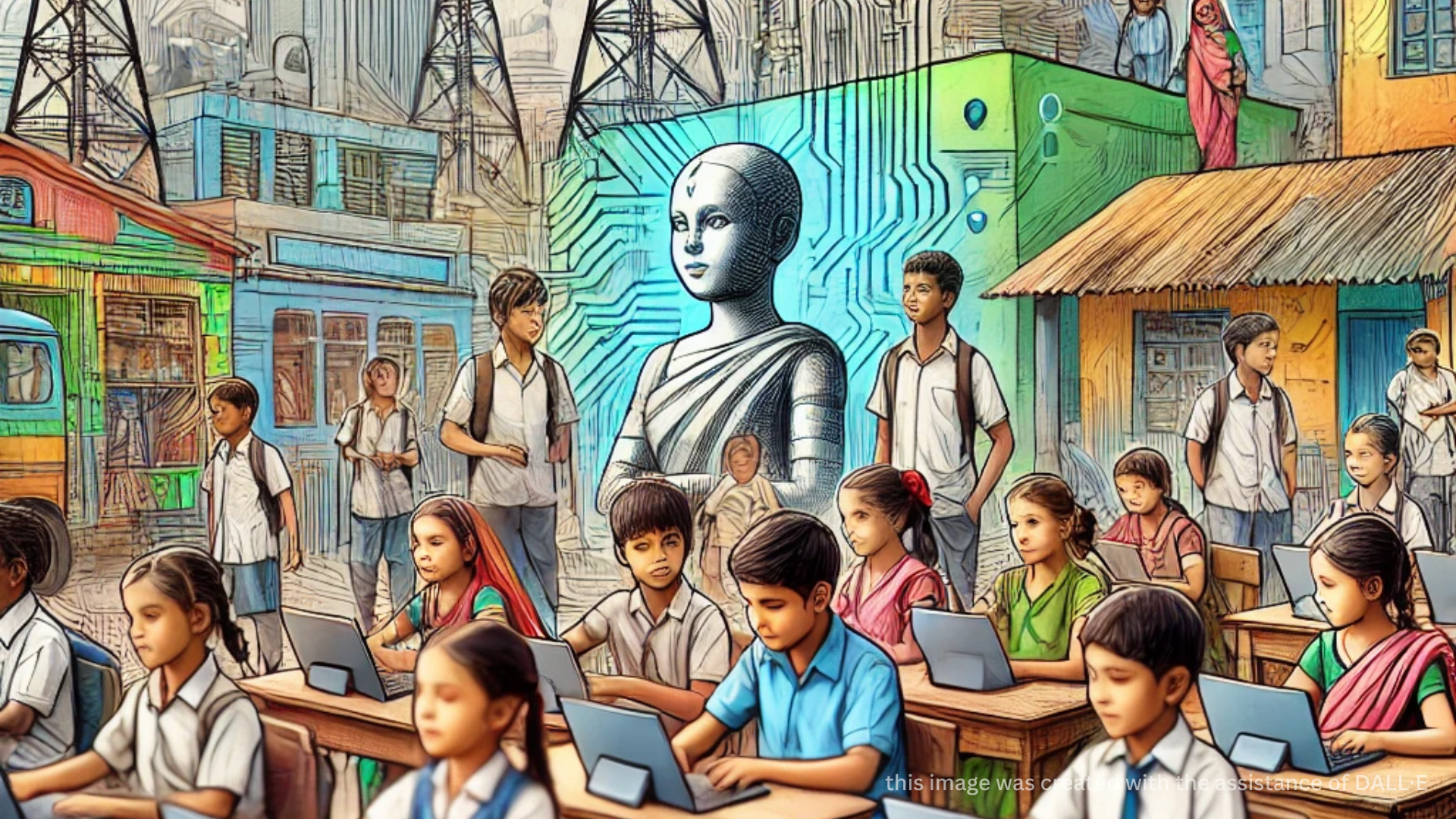Digitalisation in Education: Can AI Bridge India’s Digital Divide?
In this blogpost, Krishna Kanta Roy discusses the opportunities and challenges of AI for education in India. While AI could potentially be a powerful tool for democratising education, it also risks exacerbating existing inequalities. This blogpost is part of NORRAG’s blog series on Artificial Intelligence and Digitisation of Education.
As the world advances into the digital age, Artificial Intelligence (AI) stands at the forefront of technological advancement, promising transformative changes across various sectors, including education. In India, a nation marked by stark socio-economic disparities, the potential of AI in education is a topic of vigorous debate. The question at hand is whether AI can genuinely bridge the digital divide or if it risks exacerbating existing inequalities.
The Promise of AI in Education
AI’s potential in the educational landscape is vast. Adaptive learning systems powered by AI can provide personalised educational experiences tailored to individual student needs. This technology can identify strengths and weaknesses, offering customised content to help students progress at their own pace. For a country like India, where student-teacher ratios are often overwhelming, AI can act as an invaluable assistant, ensuring that no student is left behind due to a lack of personalised attention.
Moreover, AI can democratise access to high-quality educational resources. In rural and remote areas, where qualified teachers and infrastructure are often lacking, AI-driven tools can provide students with access to quality education that they would otherwise be deprived of. The language processing capabilities of AI can also transcend linguistic barriers, offering educational content in multiple languages and catering to India’s diverse linguistic landscape.
Challenges and Concerns
However, the optimism surrounding AI in education must be tempered with a realistic appraisal of its challenges. The foremost concern is the accessibility of AI technologies. Despite significant advancements, a substantial portion of India’s population still needs reliable internet access and digital devices. According to the Unified District Information System for Education (UDISE) 2021-22 data, only around 34% of Indian schools have internet access, and less than 50% have functional computers. This digital divide is not just a rural-urban issue but is also influenced by socio-economic factors like income, geography, culture, gender, and so on. Thus, while AI promises personalised learning, it remains out of reach for many who lack the basic digital infrastructure.
Another pressing issue is the quality of data required for AI systems to function effectively. AI thrives on data, and in an educational context, this means detailed, accurate, and up-to-date information about students’ learning habits, preferences, and challenges. However, the collection and management of such data in India face significant hurdles, including privacy concerns, data security, and the administrative capacity of educational institutions to gather and utilise this data effectively.
Equity vs. Equality
Implementing AI in education also brings the debate between equity and equality to the fore. While AI can offer equal access to learning tools, ensuring equitable outcomes requires addressing deeper systemic issues. For instance, students from marginalised communities may need additional support to utilise AI tools effectively. This includes access to devices and the internet and digital literacy training for students, teachers, and parents.
Furthermore, integrating AI into education necessitates significantly overhauling the current educational ecosystem. Teachers need to be trained not only to use AI tools but also to interpret and act on the insights provided by these tools. This shift demands investment in professional development and a rethinking of teacher training programs, often underfunded and outdated in India.
Policy Implications and the Way Forward
For AI to bridge the digital divide in India, policymakers must adopt a multi-faceted approach. First and foremost, there needs to be a concerted effort to expand digital infrastructure across the country. This includes increasing internet penetration and ensuring the affordability and accessibility of digital devices. Public-private partnerships can play a crucial role in this endeavour, leveraging the strengths of both sectors to create sustainable and inclusive digital ecosystems.
Investments in digital literacy programs are equally important. Digital literacy should be integrated into the school curriculum from an early age, equipping students with the skills needed to navigate the digital world effectively. Teacher training programs must be revamped to include digital and AI literacy, ensuring that educators are well-equipped to harness the potential of AI in the classroom.
Additionally, policies must address the ethical and privacy concerns associated with AI in education. Clear guidelines on data collection, storage, and usage must be established to protect student privacy and build trust in AI systems. Principles of transparency, accountability, and inclusivity should guide the development and deployment of AI in education.
Conclusion: A Call to Action
Integrating AI in education holds transformative potential for India, but realising this potential requires addressing significant challenges. Policymakers, educators, and stakeholders must collaborate to create an inclusive and equitable digital education landscape. By investing in infrastructure, digital literacy, and ethical guidelines, India can harness the power of AI to bridge the digital divide and ensure that every student has the opportunity to succeed in the digital age.
The journey ahead is complex and fraught with challenges but also filled with opportunities. AI can be a powerful tool for democratising education, but only if it is implemented thoughtfully and inclusively. As India stands on the brink of this digital revolution, the choices made today will shape the educational landscape of tomorrow. It is time for policymakers to act decisively, ensuring that the promise of AI in education becomes a reality for all and not just a privileged few.
The Author:
Krishna Kanta Roy is Assistant Professor at the Symbiosis School of Economics, Symbiosis International (Deemed University), Pune, India. He teaches courses such as Econometrics and International Economics. In addition to his teachings, he conducts numerous faculty development programs (FDPs) at various Indian universities, focusing on areas such as AI in education, learner-centric pedagogies, education technology and blended learning.
Email: kkroy2007@gmail.com

